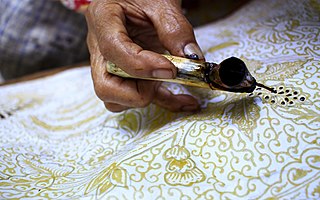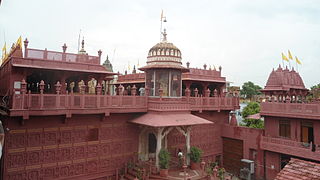
Calico is a heavy plain-woven textile made from unbleached, and often not fully processed, cotton. It may also contain unseparated husk parts. The fabric is far coarser than muslin, but less coarse and thick than canvas or denim. However, it is still very cheap owing to its unfinished and undyed appearance.

Indigo dye is an organic compound with a distinctive blue color. Indigo is a natural dye extracted from the leaves of some plants of the Indigofera genus, in particular Indigofera tinctoria; dye-bearing Indigofera plants were commonly grown and used throughout the world, in Asia in particular, as an important crop, with the production of indigo dyestuff economically important due to the historical rarity of other blue dyestuffs.

Bandhani is a type of tie-dye textile decorated by plucking the cloth with the fingernails into many tiny bindings that form a figurative design. The term bandhani is derived from the Sanskrit verbal root bandh. Today, most Bandhani making centers are situated in Gujarat, Rajasthan, Sindh, Punjab region and in Tamil Nadu where it is known as Sungudi. It is known as chunri in Pakistan. Earliest evidence of Bandhani dates back to Indus Valley civilization where dyeing was done as early as 4000 B.C. The earliest example of the most pervasive type of Bandhani dots can be seen in the 6th century paintings depicting the life of Buddha found on the wall of Cave at Ajanta. Bandhani is also known as Bandhej Saree, Bandhni, Piliya, and Chungidi in Tamil and regional dialects. Other tying techniques include Mothra, Ekdali and Shikari depending on the manner in which the cloth is tied. The final products are known with various names including Khombi, Ghar Chola, Patori and Chandrokhani.

Textile printing is the process of applying color to fabric in definite patterns or designs. In properly printed fabrics the colour is bonded with the fibre, so as to resist washing and friction. Textile printing is related to dyeing but in dyeing properly the whole fabric is uniformly covered with one colour, whereas in printing one or more colours are applied to it in certain parts only, and in sharply defined patterns.

Kasuri (絣) is the Japanese term for fabric that has been woven with fibers dyed specifically to create patterns and images in the fabric, typically referring to fabrics produced within Japan using this technique. It is a form of ikat dyeing, traditionally resulting in patterns characterized by their blurred or brushed appearance.
Ajrak, also known as Ajrakh, is a unique form of block-printing found mostly in Sindh, Pakistan and Ajrakhpur, Kutch district, India. These shawls display special designs and patterns made using block printing with stamps. Ajrak is a symbol of Sindhi culture and traditions. Ajrak prints are also famous in neighbouring areas of India, in Gujarat, due to their influence from the Indus Valley civilization. Apart from Sindh and Kutch, recently, a Saraiki version of the Ajrak called Sajarak was created and is found in South Punjab, Pakistan.

Resist dyeing (resist-dyeing) is a traditional method of dyeing textiles with patterns. Methods are used to "resist" or prevent the dye from reaching all the cloth, thereby creating a pattern and ground. The most common forms use wax, some type of paste made from starch or mud, or a mechanical resist that manipulates the cloth such as tying or stitching. Another form of resist involves using a chemical agent in a specific type of dye that will repel another type of dye printed over the top. The best-known varieties today include tie-dye, batik, and ikat.

Sanganer is a town/tehsil situated in Jaipur district, Rajasthan, 16 km south of state capital Jaipur. Jaipur has been divided in 13 Sub divisions and Sanganer is one of these 13 Sub divisions. It is famous for textile printing, handmade paper industry, and for Jain temples. Sanganer prints are one of its own kinds, for the reason that the patterns in bright colours are always printed on white backgrounds. Sanganeri Hand block printing received the geographical indication (GI) tag in 2010.
Leheria is a traditional style of tie dye practiced in Rajasthan, India that results in brightly colored cloth with distinctive patterns. The technique gets its name from the Rajasthani word for wave because the dyeing technique is often used to produce complex wave patterns.
Turkey red is a dyeing methods that was widely used to give cotton a distinctive bright red colour in the 18th and 19th centuries. It was made using the root of the rubia (madder) plant, through a long and laborious process which originated in the historical Levant region, namely being developed in India and China. Turkey red was brought to Europe in the 1740s and in France was known as rouge d'Andrinople.

Roghan painting is an art of cloth printing practiced in Gujarat, Peshawar and Sindh. In this craft, paint made from boiled castor oil or linseed oil and vegetable dyes is laid down on fabric using a stylus.

Chhipi is a caste of people with ancestral roots tracing back to India. They are found in the states of Gujarat, Rajasthan, Madhya Pradesh, Haryana, Delhi, Uttar Pradesh of India.

Natural dyes are dyes or colorants derived from plants, invertebrates, or minerals. The majority of natural dyes are vegetable dyes from plant sources—roots, berries, bark, leaves, and wood—and other biological sources such as fungi.

Kalamkari is a type of hand-painted cotton textile produced in the Indian state of Andhra Pradesh. Only natural dyes are used in Kalamkari, which involves twenty-three steps.

Bagh print is a traditional Indian handicraft originating in Bagh, Dhar district of Madhya Pradesh, India. The process is characterised by hand printed wood block relief prints with naturally sourced pigments and dyes. Bagh print motifs are typically geometric, paisley, or floral compositions design, dyed with vegetable colours of red and black over a white background, and is a popular textile printing product. Its name is derived from the village Bagh located on the banks of the Bagh River.

Mughal clothing refers to clothing adhered by the Mughals in the 16th, 17th and 18th centuries throughout the extent of their empire. Much of them were already being used in the past centuries before their arrival in Indian subcontinent. It was characterized by luxurious styles and was made with muslin, silk, velvet and brocade. Elaborate patterns including dots, checks, and waves were used with colors from various dyes including cochineal, sulfate of iron, sulfate of copper and sulfate of antimony were used.

Abdul Kadar Khatri (1961–2019) was an Indian master craftsman in the sector of traditional hand block printing known as Bagh Print. He was the son of Ismail Sulemanji Khatri, founder of Bagh print. He along with his father saved the tradition of Textile printing of Bagh from extinction and taken it to new heights. His artifacts have brought laurels to India and particular to Madhya Pradesh state from across the globe by showcasing his exceptional talent in Bagh Print in many countries. His family has been working in the trade of Traditional Bagh Hand Block print since the 7th century.
Anokhi is an Indian retailer based in Jaipur, Rajasthan, which retails textiles, clothing, furnishings, and accessories, made with traditional Indian motifs and techniques. It was founded in 1970 by husband and wife, John and Faith Singh, with a focus on reviving traditional Rajasthani hand-block or woodcut printing techniques, and the use of natural vegetable dyes. Anokhi works directly with Rajasthani craftspeople, and retails through its 25 stores in India and a few stockists in Europe and the United States.
Bagru print is a form of hand block printing done by natural colours followed by the Chippa's in Bagru, India. These prints of Bagru are acclaimed all over world. The Prints of Bagru, unlike other prints, involve a different kind of printing. The unique method for printing employs wooden block in it. In this process, the desired design is engraved first on wooden block and then carved block is used for replicating the design in the preferred color on the fabric.

The Anokhi Museum of Hand Printing is a private museum located in Amber, Rajasthan dedicated to the art of hand-block printing. Opened in 2005, the museum is an initiative of the founders of Anokhi, an Indian retail brand of block-printed clothes.
















